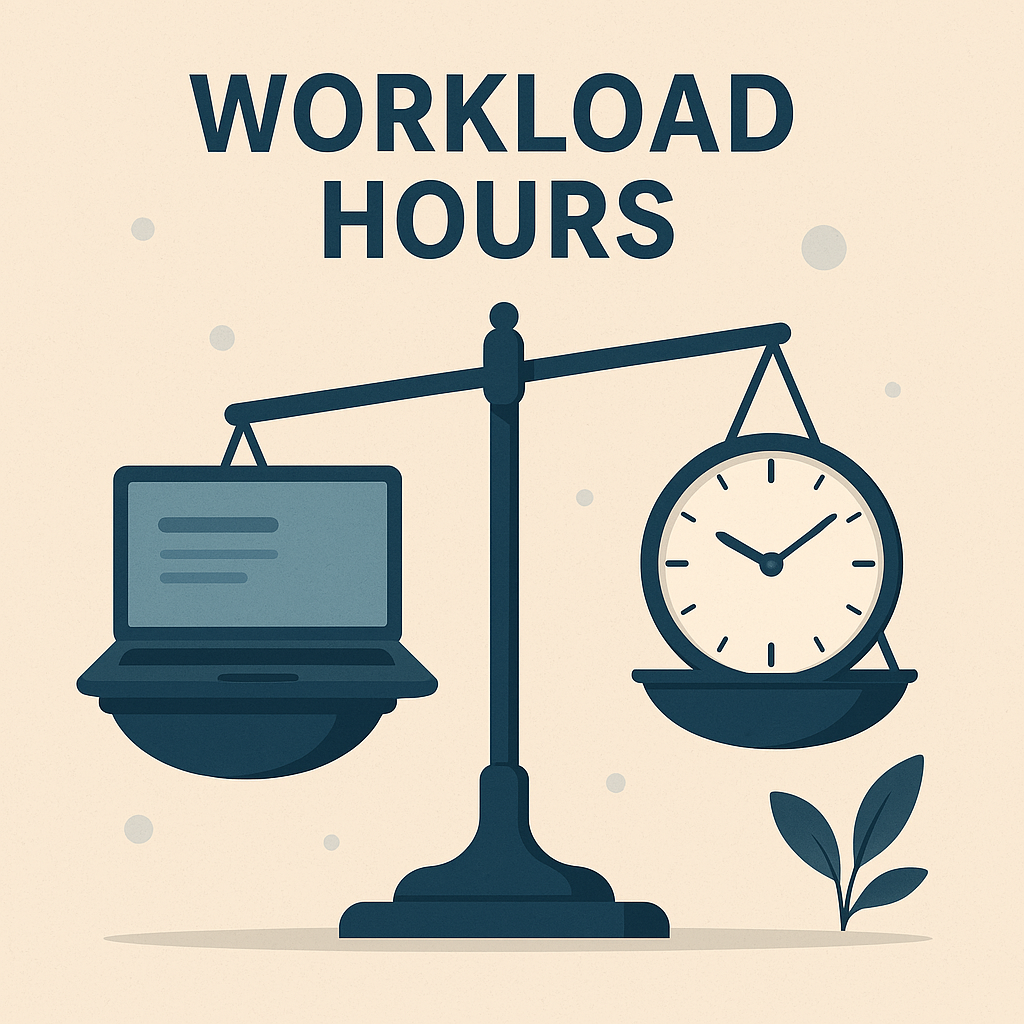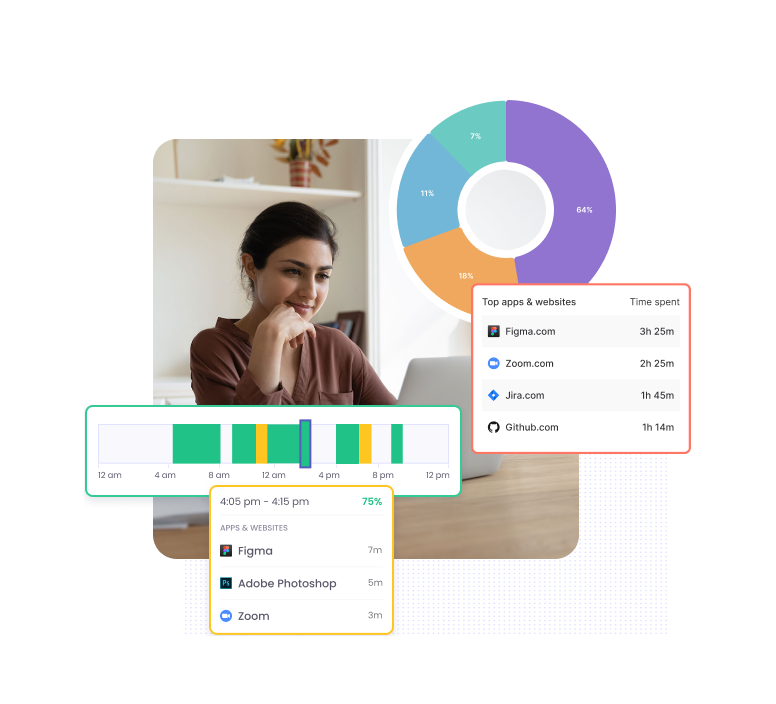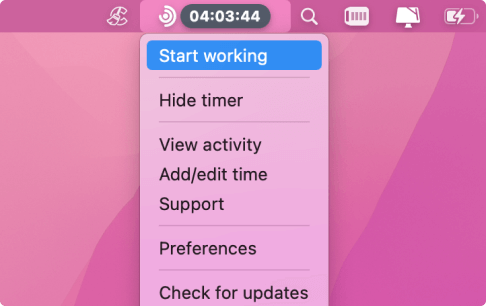
Why Measuring Workload Matters
Have you ever wondered why some employees seem constantly overwhelmed with work while others appear to have plenty of free time while somehow still managing to get everything done? The simple answer answer often lies in how work is distributed across your team and accurately (and non-invasively) you keep track of employee work hours. By learning how to calculate hours worked, managers can create a fair, productive workplace where everyone contributes to the best of their ability without being overworked.
Sarah Johnson, HR Director at Horizon Digital Solutions, explains: “Before we started measuring employee workload, we had an unsustainably high turnover in our design department. Some designers were working late every night while others seemed to be aloof. Once we ran an internal workload assessment program, everyone’s satisfaction improved dramatically.”
What Exactly Is Workload Calculation?

Simply put, calculating workload hours means figuring out how much productive work your employees do during their workday.
To do this accurately, you need to find a way to make note of the start time and end time for each worker. At the same time, it’s important to remember that the foundation of workload assessment is being able to separate valuable work time from breaks, personal activities, and downtime.
With this in mind, you need to be able to calculate and subtract unpaid breaks to determine the actual working hours. This ensures that the total hours worked are accurately calculated for payroll processing, project tracking, and determining the workload across your workforce.
Definition of Work Hours
Work hours refer to the total number of hours an employee is scheduled to work or has worked within a specific time period. This includes regular work hours, overtime hours, and break hours. Defining and understanding work hours is critical as they directly impact an employee’s pay, benefits, and overall work-life balance.
Regular work hours are the standard hours an employee is expected to work, typically defined in their respective employment contracts. Overtime hours are any hours worked beyond the regular work hours, often compensated at a higher pay rate.
Break hours, such as lunch or coffee breaks, can be either paid or unpaid, depending on company policies and labor laws. Accurately tracking these hours ensures employees are fairly compensated and helps maintain a balanced workload.
Importance of Tracking Work Hours

An essential part of calculating how many hours an employee works is being able to track their productive time. For employees, accurate tracking ensures they receive fair compensation for the hours they work, including any overtime, which is often calculated at an increased hourly pay rate. Accurate time tracking also helps prevent overworking, which can lead to burnout.
For employers, being able to track work hours is vital for managing payroll, monitoring productivity, and ensuring compliance with labor laws and regulations. By keeping accurate records of work hours, employers can identify inefficiencies, make data-driven decisions, and improve overall business operations. Additionally, tracking work hours helps in creating fair expectations and maintaining a balanced workload across everyone in the company.
Common Challenges in Calculating Workload Hours

Calculating total work hours can be a daunting task, especially for managers who oversee multiple employees with varying work schedules and pay rates. Some common challenges include accurately tracking employee hours, complex overtime calculations and accounting for break time.
Managing different approaches to work, such as employees that work part-time or with flexible schedules, makes being able to calculate work hours that much more difficult. However, compliance with labor laws and regulations, such as minimum wage and overtime requirements, is absolutely critical to a company’s operation.
At the same time, some companies may face difficulties dealing with errors or discrepancies in time tracking data. Integrating this data with payroll and accounting systems can be challenging, especially for large enterprises. In today’s digital environment, integrating automated time tracking software with other systems is a must for accurate payroll management.
Understanding Work Schedules
Work schedules can vary widely depending on the employer, industry, and job requirements. The most common types of work schedules are:
Full-time employees typically have schedules with 40 hours worked per week (typically the same start and stop times every day) and designated days off during the week.
Part-time schedules usually consist of fewer than 40 hours per week, with a varying number of hours per day and days off that change week to week.
Flexible schedules allow employees to choose their own hours or work from home, providing greater work-life balance.
Shift work involves working non-traditional hours, such as nights, weekends, or holidays, which can be challenging but necessary in certain industries.
Overtime requires employees to work more than their regular hours, often with an increase to the employee’s pay rate.
Step-by-Step Guide to Calculate Work Hours
Let’s walk through a practical example of how to calculate hours worked for an employee on a particular day:
Record the start and stop times: Employee Alex begins work at 8:30 AM and finishes at 5:45 PM.
Convert to 24-hour format (also called military time): Convert 8:30 AM to 08:30 and 5:45 PM to 17:45 for easier calculation.
Account for unpaid/unproductive time: Subtract Alex’s 45-minute lunch break and two 15-minute coffee breaks (total: 75 minutes).
Calculate the total time worked:
Subtract start time from stop time: 17:45 – 08:30 = 9 hours and 15 minutes
Convert minutes to decimal form: 15 minutes = 0.25 hours
Total hours before breaks = 9.25 hours
Subtract break time: 9.25 – 1.25 = 8 hours worked
Track the time that was spent on work-related activities: Of Alex’s 8 hours, 6.5 were spent on a single assignment, while 1.5 hours were dedicated to meetings.
This example demonstrates how to calculate work hours across different activities while accounting for non-productive time.
Pro tip: Converting work hours into decimal hours can streamline payroll calculations and ensure accurate time management. Using the 24-hour clock format, or military time, can simplify calculations and avoid confusion between AM and PM.
Accounting for Breaks
Breaks are an essential part of the workday, during which employees rest and recharge. When calculating work hours, employers must account for breaks, whether that includes paid and unpaid breaks.
Paid breaks, such as lunch breaks or coffee breaks, are included in the employee’s work hours and contribute to their total pay.
Unpaid breaks, such as time off for vacation or sick leave, are not included in the employee hours calculations. However, unpaid time off policies can vary depending on the employer and local labor laws.
By accurately tracking work hours, including breaks and overtime, employers can ensure that their employees are fairly compensated and that their business operations run smoothly.
Real-World Example: Brightsnow Marketing Agency
Let’s take a look at how Brightsnow Marketing Agency solved their workload challenges:
James Miller, Operations Director at Brightsnow, noticed their five-person content team was struggling with deadlines despite everyone claiming to be busy. Some team members regularly stayed late, while others seemed to have lighter schedules.
“We needed to understand what was really happening with our team’s time,” says Miller. “Some writers were producing twice as much content as others, yet everyone claimed to be working at capacity.”
How Brightsnow Learned to Measure Employee Workload
Miller’s team took these steps:
Tracked actual work time
Using Traqq time tracking software, they monitored how long each employee spent on different tasks.
Identified non-work activities
The team discovered surprising patterns in how time was being used:
Emma spent nearly 90 minutes daily on social media
Tyler took extended lunches averaging 75 minutes
Alexis had frequent personal calls totaling about an hour each day
Marcus was genuinely working consistently but inefficiently
Rachel was overloaded, handling multiple complex projects at the same time
Applied a simple workload calculation formula:
They also utilized Traqq as an employee hours calculator to ensure the accurate tracking of work hours, including breaks and overtime. This data was then plugged into the following workload calculation formula:
Workload Balance = 1 – (Time lost + Overtime) ÷ Total available time
For Brightsnow’s 5-person team with 8-hour workdays:
Time lost to non-work activities: 4.5 hours daily
Overtime being worked: 1.5 hours daily (mostly by Rachel)
Total available time: 5 people × 8 hours = 40 hours
Workload Balance = 1 – (4.5 + 1.5) ÷ 40 = 0.85 or 85%
Miller explains: “A healthy workload balance should be at least 95%. Our 85% score showed we had a serious workload distribution problem.”
How Brightsnow Transformed Their Workload Management
After determining how to assess workload of employees accurately, Brightsnow made several changes:
Redistributed projects: They shifted some of Rachel’s complex projects to other team members.
Created clearer expectations: The team established guidelines for breaks and personal activities.
Improved training: Marcus received additional training to work more efficiently.
Continued monitoring: Using a software solution like Traqq, they kept track of improvements in workload distribution.
Six months later, Brightway’s workload balance score improved to 96%, and the team met all client deadlines without using a cost effective strategy and without overloading their team.
Simple Ways to Measure Workload in Your Business

You don’t need complicated systems to start quantifying your organization’s workload. Here are practical approaches:
1. Keep Activity Logs
The simplest way to determine workload is having employees track their daily activities. However, self-reporting isn’t always accurate—people tend to overestimate productive time.
2. Use Time Tracking Software
Tools like Traqq automatically capture how employees spend their time, showing:
When employees clock in and out
Which applications they use
When they’re actively working
How much time goes to different projects
Periods of inactivity
This data is invaluable for managers who need to ensure productivity and accountability. Additionally, it helps in payroll management by providing accurate records of work hours.
To facilitate easy calculations of elapsed time, it is essential to convert start times from the 12-hour clock system to the 24-hour military time format.
3. Review Output vs. Hours
Compare the total time worked against the hours they work. If someone takes twice as long as others to complete similar tasks, this indicates potential workload measurement issues.
To simplify payroll calculations, it is also important to convert work hours into decimal format.
How Traqq Simplifies Workload Calculation

“Trying to measure employee workload manually was a nightmare,” says Jennifer Torres, Team Lead at Brightsnow Technologies. “We switched to Traqq and immediately gained clear insights into how work was distributed.”
Traqq helps businesses:
See real productivity patterns: Know exactly how much time employees spend on actual work versus breaks or personal activities.
Balance team workload: Identify who has capacity for more work and who’s overloaded.
Support remote teams: Monitor productivity regardless of where employees work.
Create fair expectations: Base workload targets on actual data rather than guesswork.
Improve planning: Calculate work hours accurately to estimate project timelines. By noting both the start and end times, businesses can ensure precise timekeeping and payroll calculations.
Practical Tips for Better Workload Assessment
Based on Brightsnow’s experience, here are practical tips for how to calculate workload in your company:
Be transparent: Explain to employees why you’re measuring workload and how it benefits everyone.
Start with a baseline: Measure current workload distribution before making changes, as it is a legal obligation to maintain accurate records of hours worked.
Consider job differences: Different roles naturally have different productivity patterns—account for these in your workload measures.
Check in regularly: Workload assessment shouldn’t be a one-time event. Review regularly to catch issues early. The final step is to ensure that all data is accurately recorded and analyzed.
Use the data constructively: Focus on improving balance rather than punishing low performers.
Workload Calculation Made Simple

You don’t need to be a math expert to quantify workload effectively. Start with these simple steps:
Track time spent on actual work activities for a given period
Note time spent on breaks and non-work activities
Calculate your workload balance using the formula provided above
Make adjustments based on what you discover
As Carlos Vasquez, CEO of Brightsnow Marketing, notes: “Understanding how to measure workload changed everything for us. We’re more profitable, our clients are happier, and most importantly, our team is properly balanced and less stressed.”
Whether you lead a small team or a large department, learning how to calculate workload hours is one of the most valuable skills for creating a productive, fair workplace. With tools like Traqq, this process becomes simple enough for any manager to implement successfully. The standard number of work hours, typically 2,080 hours per year or 40 hours per week, is essential for accurate payroll management.

